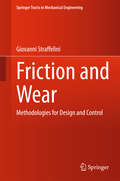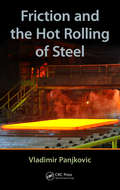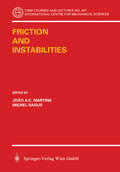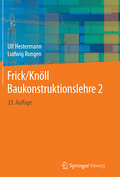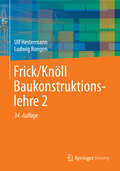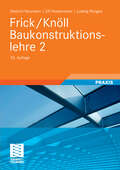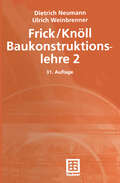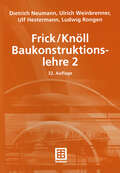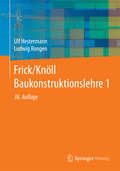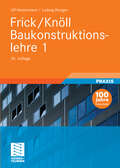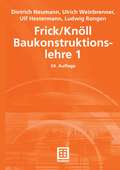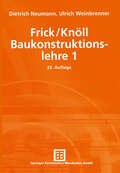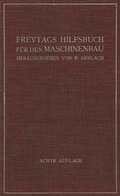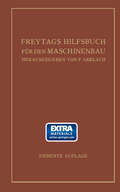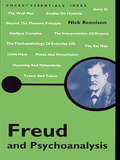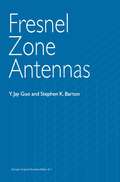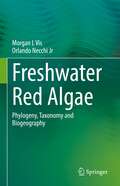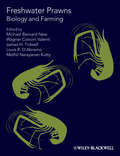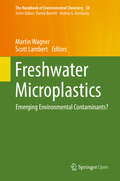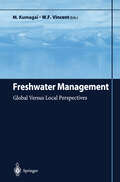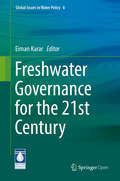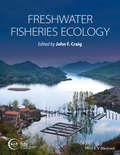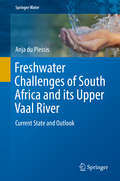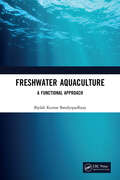- Table View
- List View
Friction and Wear: Methodologies for Design and Control (Springer Tracts in Mechanical Engineering)
by Giovanni StraffeliniThis book introduces the basic concepts of contact mechanics, friction, lubrication, and wear mechanisms, providing simplified analytical relationships that are useful for quantitative assessments. Subsequently, an overview on the main wear processes is provided, and guidelines on the most suitable design solutions for each specific application are outlined. The final part of the text is devoted to a description of the main materials and surface treatments specifically developed for tribological applications and to the presentation of tribological systems of particular engineering relevance. The text is up to date with the latest developments in the field of tribology and provides a theoretical framework to explain friction and wear problems, together with practical tools for their resolution. The text is intended for students on Engineering courses (both bachelor and master degrees) who must develop a sound understanding of friction, wear, lubrication, and surface engineering, and for technicians or professionals who need to solve tribological problems in their work.
Friction and the Hot Rolling of Steel
by Vladimir PanjkovicWhen it comes to metal rolling, understanding and controlling frictional phenomena is essential to improving product and developing a more effective approach to friction reduction. Providing a historical perspective that goes as far back as the days of Leonardo da Vinci and continues up until the present day, Friction and the Hot Rolling of Steel c
Friction and Instabilities (CISM International Centre for Mechanical Sciences #457)
by J. A. C. Martinis M. RaousThe book addresses instability and bifurcation phenomena in frictional contact problems. The treatment of this subject has its roots in previous studies of instability and bifurcation in elastic, thermoelastic or elastic-plastic bodies, and in previous mathematical, mechanical and computational studies of unilateral problems. The salient feature of this book is to put together and develop concepts and tools for stability and bifurcation studies in mechanics, taking into account the inherent non-smoothness and non-associativity (non-symmetry) of unilateral frictional contact laws. The mechanical foundations, the mathematical theory and the computational algorithms for such studies are developed along six chapters written by the lecturers of a CISM course. Those concepts and tools are illustrated not only with enlightening academic examples but also with some demanding industrial applications, related, namely, to the automotive industry.
Frick/Knöll Baukonstruktionslehre 2
by Ulf Hestermann Ludwig RongenDer Frick/Knöll gibt die passenden Antworten auf alle Fragen moderner Bauweisen als Grundlage. Die 34. Auflage wurde komplett überarbeitet und den aktuellen gültigen Normen angepasst. Seit 1909 gibt der Frick/Knöll Generationen von Architekten und Ingenieuren einen umfassenden Einblick in die Baukonstruktionslehre. Der große Erfolg dieses Werkes ergibt sich aus der umfassenden und ganzheitlichen Betrachtung von Roh- und Innenausbau. Das betrifft nicht nur die traditionellen Techniken, sondern auch den Trockenbau mit seiner zunehmenden Bedeutung als Fertigungsprinzip.
Frick/Knöll Baukonstruktionslehre 2
by Ulf Hestermann Ludwig RongenDer Frick/Knöll gibt die passenden Antworten auf alle Fragen moderner Bauweisen als Grundlage. Die 34. Auflage wurde komplett überarbeitet und den aktuellen gültigen Normen angepasst. Seit 1909 gibt der Frick/Knöll Generationen von Architekten und Ingenieuren einen umfassenden Einblick in die Baukonstruktionslehre. Der große Erfolg dieses Werkes ergibt sich aus der umfassenden und ganzheitlichen Betrachtung von Roh- und Innenausbau. Das betrifft nicht nur die traditionellen Techniken, sondern auch den Trockenbau mit seiner zunehmenden Bedeutung als Fertigungsprinzip.
Frick/Knöll Baukonstruktionslehre 2
by Dietrich Neumann Ulf Hestermann Ludwig RongenDer Frick/Knöll gibt die passenden Antworten auf alle Fragen moderner Bauweisen als Grundlage. Die 33. Auflage wurde komplett überarbeitet und den aktuellen gültigen Normen angepasst. Seit 1909 gibt der Frick/Knöll Generationen von Architekten und Ingenieuren einen umfassenden Einblick in die Baukonstruktionslehre. Der große Erfolg dieses Werkes ergibt sich aus der umfassenden und ganzheitlichen Betrachtung von Roh- und Innenausbau. Das betrifft nicht nur die traditionellen Techniken, sondern auch den Trockenbau mit seiner zunehmenden Bedeutung als Fertigungsprinzip. "... Ein wirkliches Standardwerk der Baukonstruktionen." Süddeutsche Bauwirtschaft
Frick / Knöll Baukonstruktionslehre 2
by Dietrich Neumann Ulrich WeinbrennerVor über 90 Jahren erschien erstmals der "Frick/Knöll" als Leitfaden für den Unterricht an den Königlich Preußischen Baugewerkschulen. Seither hat sich das damalige dünne Bändchen zum unverzichtbaren 1500seitigen zweibändigen Standardwerk in Lehre und Baupraxis für den Rohbau und den raumbildenden Innenausbau entwickelt, das seither mit fast 575.000 Exemplaren aufgelegt wurde. Damit war es ein zuverlässiger Begleiter für Generationen von Architekten und Bauingenieuren auf dem Weg in den Beruf und im späteren Berufsleben. Die Neuauflage dieses Standardwerkes wurde auf Fehler durchgesehen und verweist auf alle aktuellen deutschen und europäischen Normen.
Frick/Knöll Baukonstruktionslehre 2
by Dietrich Neumann Ulrich Weinbrenner Ulf Hestermann Ludwig RongenDer Frick/Knöll gibt die passenden Antworten zum Grundlagenwissen moderner Bauweisen - jetzt erweitert um das Kapitel "Fassadenflächen in Pfosten-Riegelbauweise". Die 32. Auflage wurde überarbeitet und den aktuellen gültigen Normen angepasst. Seit 1909 gibt der Frick/Knöll Generationen von Architekten und Ingenieuren einen umfassenden Einblick in die Baukonstruktionslehre. Der große Erfolg dieses Werkes ist auf der umfassenden und ganzheitlichen Betrachtung von Roh- und Innenausbau begründet. Dies betrifft sowohl die tradtionellen Techniken als auch den Trockenbau entsprechend seiner zunehmenden Bedeutung als Fertigungsprinzip. Wichtige Neuerungen sind unter anderem: Neue Holzwerkstoffe bei Dächern - Steildachelemente aus Holz - Textile Flächentragwerke - Abgasanlagen - EnEV bei Fenstern - Einbruchshemmung bei Fenster und Türen - Angriffshemmende Verglasung - Sicherheitsnetze bei Gerüsten und Abstützungen
Frick/Knöll Baukonstruktionslehre 1
by Ulf Hestermann Ludwig RongenIn der vollständig überarbeiteten und aktualisierten 36. Auflage des Bandes 1 werden neben der Berücksichtigung des aktuellsten Standes der Normung und praxisrelevanten Richtlinien besonders zeitgemäße Konstruktionsprinzipien aus den Bereichen Glasfassaden sowie innovative Materialentwicklungen des Bauens mit Beton neu behandelt. Der Abschnitt 6 wurde mit Blick auf die seit dem 01.Mai 2014 gültige EnEV 2014 völlig neu bearbeitet. Umfassend neu bearbeitet wurde auch Abschnitt 13 „Systemböden, Installationssysteme in der Bodenebene“. Im Abschnitt 17.5 „Wärmeschutz“ wurde das Thema „Innendämmung“, das zunehmend wichtiger wird, stärker beleuchtet. Hier hat es sich als zielführend erwiesen, nicht die jeweils aktuellen nationalen Normen heranzuziehen (die ohnehin in Deutschland, Österreich und in der Schweiz unterschiedlich sind), sondern auf die nach wie vor gültigen internationalen Normen und den Passivhaus Standard Bezug zu nehmen. Diese mehr an der Physik orientierten Vorgaben sind vergleichsweise stabil.Die Frick/Knöll Baukonstruktionslehre ist nach wie vor das Nachschlagewerk zu allen baukonstruktiven Fragestellungen vom Fundament über den Innenausbau bis zum Dach.
Frick/Knöll Baukonstruktionslehre 1
by Ulf Hestermann Ludwig RongenSeit einem Jahrhundert gibt der "Frick/Knöll" Generationen von Architekten und Bauingenieuren einen umfassenden Einblick in die Baukonstruktionslehre. Vom Fundament über den Innenausbau bis zum Dach bietet das Standardwerk kompaktes Grundwissen und berücksichtigt aktuelle Neuentwicklungen und die immer stärker anwachsende Zahl von Normen und anderen Baubestimmungen. Der „Frick/Knöll“ ist damit ein unentbehrlicher und zuverlässiger Begleiter für jeden Studierenden und Praktiker. Schwerpunkt der vollständig überarbeiteten und aktualisierten Jubiläumsausgabe von Band 1 ist das Thema "Energieeffizienz" mit dem neu aufgenommenen Kapitel „Bauen im Passivhausstandard“. Für die Bearbeitung des Abschnitts „Wärmeschutz“ konnte der renommierte Physiker Prof. Dr. Wolfgang Feist gewonnen werden.
Frick/Knöll Baukonstruktionslehre 1
by Dietrich Neumann Ulf Hestermann Ludwig Rongen Ulrich WeinbrennerSeit 1909 gibt der "Frick/Knöll" Generationen von Architekten und Bauingenieuren einen umfassenden Einblick vom Fundament bis zum Dach. Das Standardwerk der Baukonstruktionslehre ist damit ein unentbehrlicher und zuverlässiger Begleiter für jeden Studierenden und Praktiker. Neben kompaktem Grundwissen berücksichtigt der "Frick/Knöll" aber auch die aktuellen Neuentwicklungen und die immer stärker anwachsende Zahl von Normen und anderen Baubestimmungen. Für die 34. aktualisierte Auflage wurde das Kapitel "Beton- und Stahlbetonbau" aufgrund der verkürzten Übergangsfrist der DIN 1045 vollständig neu bearbeitet. Der große Erfolg des Buches ist in seiner ganzheitlichen Betrachtung von Roh- und Innenausbau begründet. Das betrifft sowohl die traditionellen Techniken als auch den Trockenbau mit seiner zunehmenden Bedeutung als Fertigungsprinzip und die Verwendung von Bauelementen.
Frick/Knöll Baukonstruktionslehre 1
by Dietrich Neumann Ulrich WeinbrennerDas Standardwerk der Baukonstruktionslehre Teil 1 ist ein unentbehrlicher Begleiter für jeden Studenten, der vom ersten Semester bis ins Berufsleben kompaktes und ausführliches Wissen benötigt. Das Buch erklärt den Rohbau detailliert von den Grundbegriffen bis zu den einzelnen Teilabschnitten des Hochbaus. Der Frick/Knöll gibt seit 1909 Generationen von Architekten und Bauingenieuren einen umfassenden Einblick vom Fundament bis zum Dach. Die Neuauflage berücksichtigt die technischen Weiterentwicklungen, die aktuellen deutschen Bauvorschriften (z.B. die neue Energieeinsparverordnung), die Fortschreibung der deutschen Normen sowie die Weiterentwicklung der europäischen und internationalen Normung.
Freytags Hilfsbuch für den Maschinenbau für Maschineningenieure sowie für den Unterricht an technischen Lehranstalten
by M. Coenen E. Lupberger A. Schmidt G. Unold Fr. Wicke C. ZietemannDieser Buchtitel ist Teil des Digitalisierungsprojekts Springer Book Archives mit Publikationen, die seit den Anfängen des Verlags von 1842 erschienen sind. Der Verlag stellt mit diesem Archiv Quellen für die historische wie auch die disziplingeschichtliche Forschung zur Verfügung, die jeweils im historischen Kontext betrachtet werden müssen. Dieser Titel erschien in der Zeit vor 1945 und wird daher in seiner zeittypischen politisch-ideologischen Ausrichtung vom Verlag nicht beworben.
Freytags Hilfsbuch für den Maschinenbau für Maschineningenieure sowie für den Unterricht an technischen Lehranstalten: Bericht
by Paul GerlachDieser Buchtitel ist Teil des Digitalisierungsprojekts Springer Book Archives mit Publikationen, die seit den Anfängen des Verlags von 1842 erschienen sind. Der Verlag stellt mit diesem Archiv Quellen für die historische wie auch die disziplingeschichtliche Forschung zur Verfügung, die jeweils im historischen Kontext betrachtet werden müssen. Dieser Titel erschien in der Zeit vor 1945 und wird daher in seiner zeittypischen politisch-ideologischen Ausrichtung vom Verlag nicht beworben.
Freud And Psychoanalysis: Everything You Need To Know About Id, Ego, Super-Ego and More (A\pocket Essentials Guide Ser.)
by Nick RennisonSigmund Freud was one of the giants of 20th century thought. His ideas have been hugely influential not only in psychology but in all the social sciences and the arts. Even those who have never read a word of his writings are familiar with his concepts of the id, the ego, the Oedipus complex and the workings of the unconscious mind.This looks at Freud's life from his birth in the small Moravian town of Freiburg in 1856 to his death in Hampstead in 1939. Each of Freud's major works is summarised and his central ideas explored. Controversies over his methods and practices are examined. Did he, as some critics have alleged, turn his back on evidence of genuine child abuse in 1890s Vienna and prefer instead to ascribe it to fantasy and wish fulfilment? What were the reasons behind his terrible quarrel with Carl Gustav Jung? Does his 'talking cure' of psychoanalysis actually work? The essential information about Freud's enormously productive life and career is all here.
Fresnel Zone Antennas
by Y. Jay Guo Stephen K. BartonWritten by leading experts in the field, this book is a research monograph on Fresnel zone antennas. Readers will find a wealth of novel antenna configurations, first-hand experimental results, and a large number of equations.
Freshwater Red Algae: Phylogeny, Taxonomy and Biogeography
by Morgan L Vis Orlando Necchi JrThis book presents the phylogeny, taxonomy and biogeography of freshwater red algae. Its content is divided into five chapters. The first chapter provides a brief history of freshwater red algal research, habits and collecting methods, general biogeographic trends and an overview of the taxonomic/phylogenetic placement of freshwater taxa. The other four chapters are taxonomic treatments of non-marine red algae based on taxonomic levels, i.e. classes within the phylum Rhodophyta, orders within each class, families within each order, and genera within each family. Descriptions, phylogenetic data (including numerous trees), geographic range (maps for most species) and dichotomous keys for identification are presented. Comprehensive data are provided for more than 220 species.
Freshwater Prawns: Biology and Farming
by Michael Bernard New Wagner Cotroni Valenti James H. Tidwell Methil Narayanan Kutty Louis R. D'AbramoCovering general biology and every aspect of farming freshwater prawns, from current research to development and commercial practice, this has become widely viewed as a landmark publication in the field. The well-known team of editors, New, Valenti, Tidwell, D’Abramo and Kutty, have gathered cutting-edge contributions from the world's leading experts to provide farm personnel, business managers, researchers and invertebrate, freshwater and crustacean biologists with an essential resource.
Freshwater Microplastics: Emerging Environmental Contaminants? (The Handbook of Environmental Chemistry #58)
by Martin Wagner Scott LambertThis book is open access under a CC BY 4.0 license.This volume focuses on microscopic plastic debris, also referred to as microplastics, which have been detected in aquatic environments around the globe and have accordingly raised serious concerns. The book explores whether microplastics represent emerging contaminants in freshwater systems, an area that remains underrepresented to date. Given the complexity of the issue, the book covers the current state-of-research on microplastics in rivers and lakes, including analytical aspects, environmental concentrations and sources, modelling approaches, interactions with biota, and ecological implications. To provide a broader perspective, the book also discusses lessons learned from nanomaterials and the implications of plastic debris for regulation, politics, economy, and society. In a research field that is rapidly evolving, it offers a solid overview for environmental chemists, engineers, and toxicologists, as well as water managers and policy-makers.
Freshwater Management: Global Versus Local Perspectives
by Warwick F. Vincent Michio KumagaiThe globalization of trade, monetary and fiscal policies, capital markets, and investment patterns is reshaping the world economy and is leading to new financial, commercial, and marketing structures as well as unprecedented economies of scale. Simultaneously, national and international awareness and to strengthen. There is consensus among responses to accelerating environmental degradation continue most developed countries that the rapidly evolving new economic order needs to be well integrated with policies to maintain or restore environmental quality. Many challenges remain, however, in evaluating the geo-ecological implications of economic globalization, and in formulating the appropriate management responses. In lakes and rivers, the management of water supply and quality has largely proceeded on the basis of local considerations rather than at the global scale that has been more typical of environmental management of the atmosphere and ocean. It is increasingly apparent, however, that high-quality water resources are now in critically short supply not only because of local problems such as over-irrigation and eutrophication, but also as a result of larger-scale climate effects on the hydrosphere. This magnitude of impact will increasingly require the integrated monitoring and management of water resources on a planetary scale, with world criteria for environmental assessment, restoration, and conservation strategies. The increasing extent of world trade in potable freshwater heightens the urgency for establishing international approaches, criteria, and regulations.
Freshwater Governance for the 21st Century (Global Issues in Water Policy #6)
by Eiman KararThe objective of this book is to broadly illustrate the key aspects of water governance, mapping the spectrum of decision-making from techno-centric and eco-centric approaches, to hybrid concepts and people-centric approaches. Topics covered include the challenges for water-governance models, the polycentric model, the integration challenge, water in the decision-making hierarchy, and the rise of water-sensitive design, while also taking into account interdependencies between stakeholders, as well as the issue of scale. The book’s content is presented in an integrated and comprehensive format, building on detailed case studies from around the world and the authors’ working experiences in the water sector. Combining essential insights with accessible, non-technical language, it offers a valuable resource for academics, technicians and policy-makers alike.
Freshwater Fisheries Ecology
by John F. CraigInland fisheries are vital for the livelihoods and food resources of humans worldwide but their importance is underestimated, probably because large numbers of small, local operators are involved. Freshwater Fisheries Ecology defines what we have globally, what we are going to lose and mitigate for, and what, given the right tools, we can save. To estimate potential production, the dynamics of freshwater ecosystems (rivers, lakes and estuaries) need to be understood. These dynamics are diverse, as are the earth's freshwater fisheries resources (from boreal to tropical regions), and these influence how fisheries are both utilized and abused. Three main types of fisheries are illustrated within the book: artisanal, commercial and recreational, and the tools which have evolved for fisheries governance and management, including assessment methods, are described. The book also covers in detail fisheries development, providing information on improving fisheries through environmental and habitat evaluation, enhancement and rehabilitation, aquaculture, genetically modified fishes and sustainability. The book thoroughly reviews the negative impacts on fisheries including excessive harvesting, climate change, toxicology, impoundments, barriers and abstractions, non-native species and eutrophication. Finally, key areas of future research are outlined. Freshwater Fisheries Ecology is truly a landmark publication, containing contributions from over 100 leading experts and supported by the Fisheries Society of the British Isles. The global approach makes this book essential reading for fish biologists, fisheries scientists and ecologists and upper level students in these disciplines. Libraries in all universities and research establishments where biological and fisheries sciences are studied and taught should have multiple copies of this hugely valuable resource. About the EditorJohn Craig is Editor-in-Chief of the Journal of Fish Biology and has an enormous range of expertise and a wealth of knowledge of freshwater fishes and their ecology, having studied them around the globe, including in Asia, North America, Africa, the Middle East and Europe. His particular interests have been in population dynamics and life history strategies. He is a Fellow of the Linnean Society of London and the Royal Society of Biology.
Freshwater Fisheries Ecology
by John F. CraigInland fisheries are vital for the livelihoods and food resources of humans worldwide but their importance is underestimated, probably because large numbers of small, local operators are involved. Freshwater Fisheries Ecology defines what we have globally, what we are going to lose and mitigate for, and what, given the right tools, we can save. To estimate potential production, the dynamics of freshwater ecosystems (rivers, lakes and estuaries) need to be understood. These dynamics are diverse, as are the earth's freshwater fisheries resources (from boreal to tropical regions), and these influence how fisheries are both utilized and abused. Three main types of fisheries are illustrated within the book: artisanal, commercial and recreational, and the tools which have evolved for fisheries governance and management, including assessment methods, are described. The book also covers in detail fisheries development, providing information on improving fisheries through environmental and habitat evaluation, enhancement and rehabilitation, aquaculture, genetically modified fishes and sustainability. The book thoroughly reviews the negative impacts on fisheries including excessive harvesting, climate change, toxicology, impoundments, barriers and abstractions, non-native species and eutrophication. Finally, key areas of future research are outlined. Freshwater Fisheries Ecology is truly a landmark publication, containing contributions from over 100 leading experts and supported by the Fisheries Society of the British Isles. The global approach makes this book essential reading for fish biologists, fisheries scientists and ecologists and upper level students in these disciplines. Libraries in all universities and research establishments where biological and fisheries sciences are studied and taught should have multiple copies of this hugely valuable resource. About the EditorJohn Craig is Editor-in-Chief of the Journal of Fish Biology and has an enormous range of expertise and a wealth of knowledge of freshwater fishes and their ecology, having studied them around the globe, including in Asia, North America, Africa, the Middle East and Europe. His particular interests have been in population dynamics and life history strategies. He is a Fellow of the Linnean Society of London and the Royal Society of Biology.
Freshwater Challenges of South Africa and its Upper Vaal River: Current State and Outlook (Springer Water)
by Anja Du PlessisThis book promotes better understanding and awareness of South Africa' significant water problems by describing the country's and especially the Upper Vaal River’s water resources. It is a “go-to” book for students, professionals and regular citizens when information is required regarding the country's and more specifically the Upper Vaal River’s freshwater resources. It highlights the major problems and risks which need to be addressed and give a realistic and true representation of the current water affairs.
Freshwater Aquaculture: A Functional Approach
by Biplab Kumar BandyopadhyayFreshwater Aquaculture – the study of breeding, rearing and commercialization of organisms, fish in particular, which inhabit in fresh water. Even though there remains some fragmentary information regarding the history of development of aquaculture in India but those seem to be far from being complete. In the present communication, the same has been given elaborately. The book concentrates on the culture technology of commercially important fresh water fishes. Various types of culture techniques including Aquaponics, Bioflocs, Recirculatory Aquaculture Systems (RAS) apart from the conventional Cage culture, Pen culture, Integration of fish culture with other crops viz. paddy, vegetables, dairy, piggery, poultry etc. have been dispensed in detail. Note: T&F does not sell or distribute the Hardback in India, Pakistan, Nepal, Bhutan, Bangladesh and Sri Lanka.
